Prelude
Wanna hit that repeater on that mountain miles away?
Think you need some “up tilt” to your signal to make the most of your RF link?
Think again or more appropriately think it through.
Unless you are in seriously deep canyon country or in a highrise metro area where the repeater antennas can literally be above your head, you must understand most mountain top repeater antennas are more “over there” than “up there.”
With me so far? Yes? No? Let’s work some trig to understand the problem.
Sig Trig
This figure details the typical situation of a repeater antenna and its users at various distances.
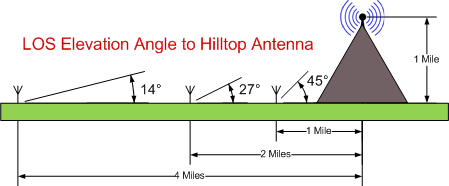
Using good ole “tangent” we can calculate the angle of the 1 mile high repeater out to various distances. Despite the impressive height, it doesn’t take many miles before the required line of site (LOS) angle begins to hug the treetops.
There exists, I’m sure, repeaters placed to fill in valleys, canyons and urban canyons. It is certainly true a low gain, broad vertical beamwidth antenna would help maximize signal into and back from the repeater. Two questions come to mind though:
- Isn’t the path loss small when you are practically under the repeater?
- Aren’t most repeaters designed to service a broad area?
Yes to both IMHO.
RF Path Loss
If you have to look up at the repeater you should have such a low path loss that you can tolerate all sorts of other losses and still come out way ahead. The one culprit remaining is multi-path and little helps us get around this unfortunate fact of life. This may lead you to a super deep null that you can get out of by moving inches in any direction.
Repeater Service Area
With a few notable exceptions, most repeaters are designed to cover broad service areas measured in the tens of miles radius. As we see in the figure above, distances beyond 4 miles converge to terrain hugging low RF path angles.
Let’s take the tangent calculations a bit further in this figure…
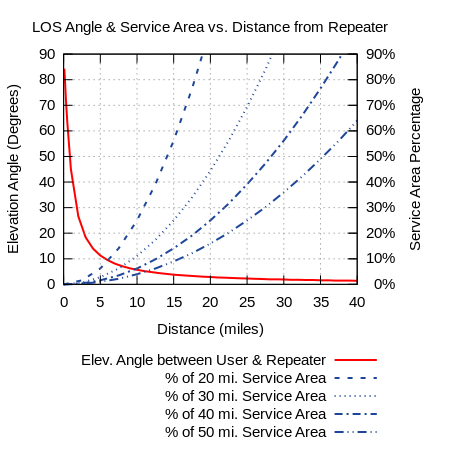
The red trace shows the RF link angle vs. distance from the same repeater 1 mile above the local terrain. The blue traces detail the percentage of coverage areas vs. the desired coverage radius; This reveals to us the concept most repeater users sit at distances where the required elevation angle is very low.
The point
The point is to address the questions some have concerning gain antennas on their mobiles. Is there an advantage to a higher gain whip to improve access to repeaters? Setting aside the canyon, urban canyon exceptions, the answer is most likely an emphatic… probably.
I’m not really helping you am I.
Well, let’s compare two of the classic mobile antenna configurations: the quarter-wave whip and the 5/8 wave whip. Here are NEC simulations of each length at 440 and 146 MHz above a wire mesh “car roof” about 4 feet above earth. Is this simulating a real car? Not quite, but certainly reveals more truth than idealized simulations.
1/4 Wave vs. 5/8 Wave on Car Roof at 440 MHz
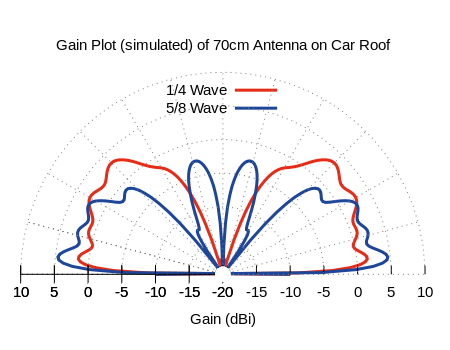
Grotesque you say? That 1/4 wave shape is just plain odd. Such is the life of an antenna over an arbitrary size conductive surface floating above the earth.
Yes… the 5/8 yields plus 3 dB
Hey the 5/8 wave antenna offers a rewarding 3 dB or so gain over the quarter wave at a low elevation angle thanks to the relatively large, with respect to wavelength, metal rooftop. It’s long been said the 5/8 wave antenna only offers a benefit over a large perfect ground. Simulations agree and this one suggests the rooftop is large enough to actually achieve the benefit.
High Elevation Angle Radiation
Both antenna have elevation coverage to 45 degrees… more than enough, and I say more than anyone needs, for most any situation.
Next we try 2m whips.
1/4 Wave vs. 5/8 Wave on Car Roof at 146 MHz

No… the 5/8 doesn’t provide much gain
Once again we see the 5/8 wave has a slight edge over the 1/4 wave, but hardly noticeable; The rooftop is not so large at the 2m wavelength negating the theoretical 5/8 wave advantage.
Modest Elevation Angle Radiation
Both provide coverage to 30 degrees elevation. I suspect the primary advantage of the 5/8 wave antenna reported by owners is more about it’s higher current peak above ground than any real improvement in performance; This is evident by the slight lowering of the ground-effect lobes.
Being single current-node (aka not collinear) antennas, the surrounding terrain dominates the elevation patterns of both antennas and bands despite all, but the most precarious vehicle angles.
What’s the green trace?
I couldn’t help throwing in the appropriately designed and spaced collinear J-Pole for comparison. Where the 1/4 wave might last a few decades, the 5/8 wave a few years and the big collinear a few minutes atop a car, it is an interesting reference to see how a properly designed collinear antenna is ideal for hitting all, but the most in-your-face repeaters.
Repeater Antenna Reciprocity
A good way to think about this is if the repeater you are hitting from miles away uses a good DB224 4 bay collinear, the builders know wasting energy at high angles is, well waste. Why should your antenna at the other end of the link be any different?
On the other hand, if the canyon filler repeater uses a simple DB201 with very broad elevation coverage, that’s your clue your antenna might benefit from being the same style.
Viva la choice.
Airport Base Station Antenna
The question of what base antenna to use for airport to aircraft communications comes up often and the parallels are striking. Take the above figure of the repeater on the mountain top and replace it with an aircraft flying one mile high. Once again we see almost always the plane is more over there than up there and if it is up there, it is close. If it is way way up there, then you don’t care about it.
This is why two, four or eight bay collinear antennas are often the right choice for airport comms.
Conclusions?
This post is food for thought mostly. It’s a response to my perception some folks seem to think high angle antennas are necessary for repeaters when they are almost always not.
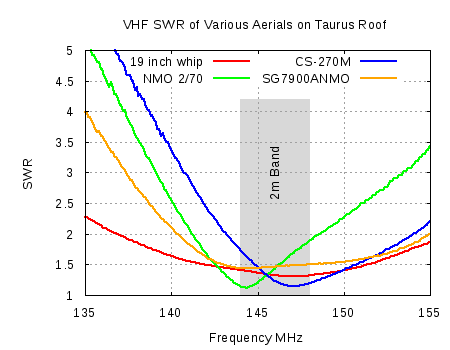
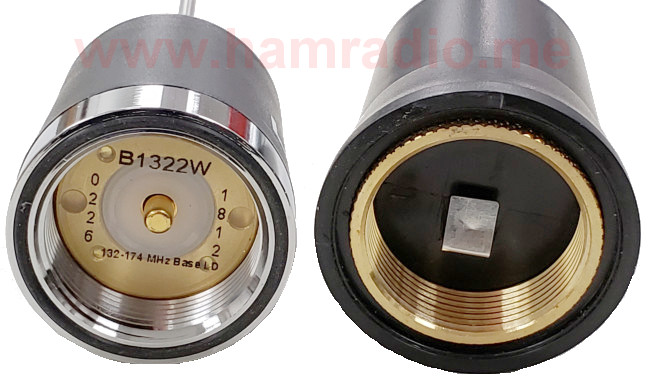
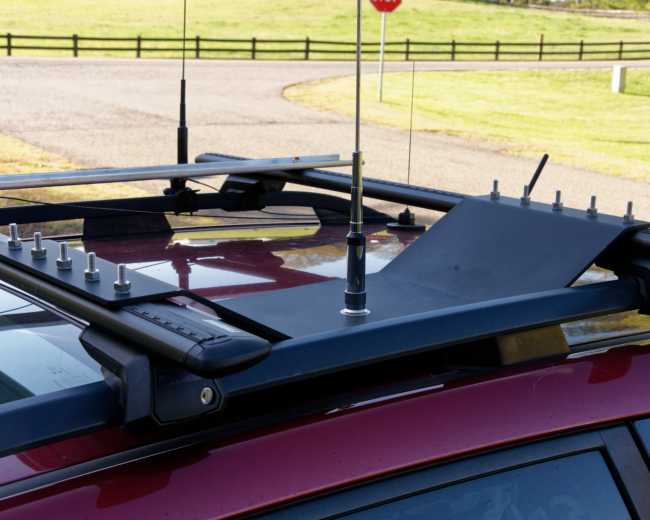

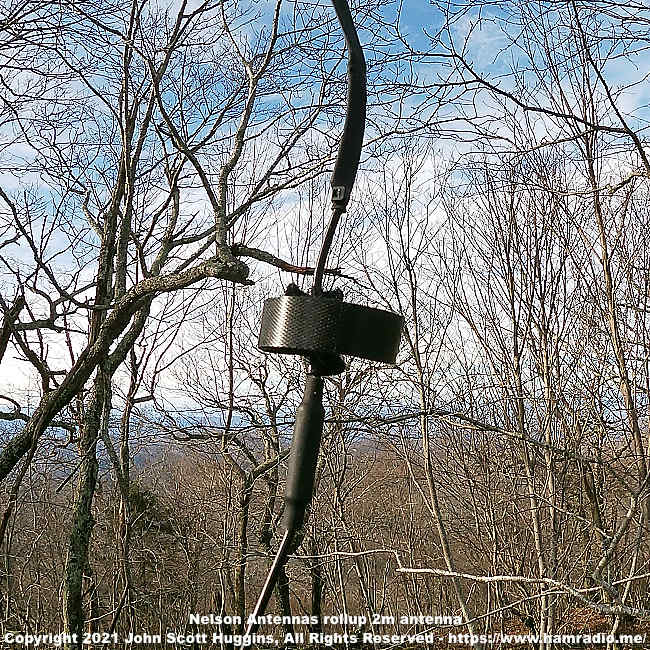
I include metal mass of roof (primary pland), glass height to lower hoods (secondary plane) and best or strongest placement in my choice of mobile antennas..front to back reflection for transmit and receive, and mag mounts usually are not grounded to body but Ive never had an issue with performance.
Kb8qlz